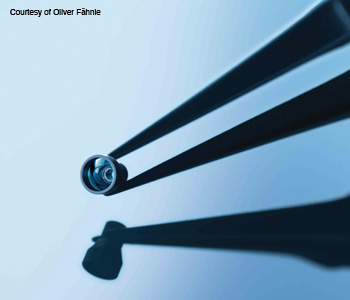Optical Engineering
Fabricating Aspherical Lenses
Although aspherical lenses are essential to many optical systems, their manufacture is notoriously complicated. Here, Oliver Fähnle from FISBA OPTIK AG shares his views on aspherical lens fabrication and the methods his lab applies in order to achieve optimum results with minimal slope and shape errors.
 A typical small FISBA objective consisting of several concave and convex lenses cemented together, featuring radii of 0.4 mm and diameters down to 0.6 mm.
A typical small FISBA objective consisting of several concave and convex lenses cemented together, featuring radii of 0.4 mm and diameters down to 0.6 mm.
A spherical lenses can be found in a wide range of instruments, including telescopes, endoscopes, graphical mapping systems and interferometric metrology machines. They provide lightweight, high-performing optical system solutions without the multi-lens setup required by most spherical systems. This is because aspherical lenses allow for surfaces of varying local radii of curvature to focus light into a minimum focal spot. However, limited optical fabrication techniques (OFTs) often force optical designers into using less-than-optimal spherical lens systems. Here, we describe the advantages of aspherical lens systems and efficient methods of manufacturing them.
…Log in or become a member to view the full text of this article.
This article may be available for purchase via the search at Optica Publishing Group.
Optica Members get the full text of Optics & Photonics News, plus a variety of other member benefits.
